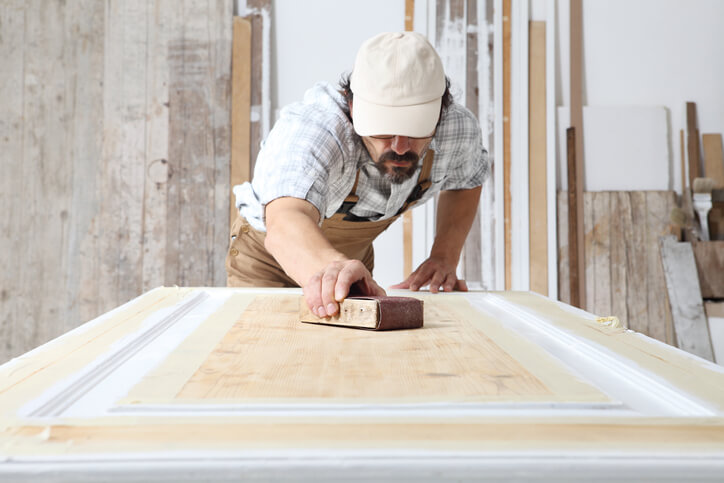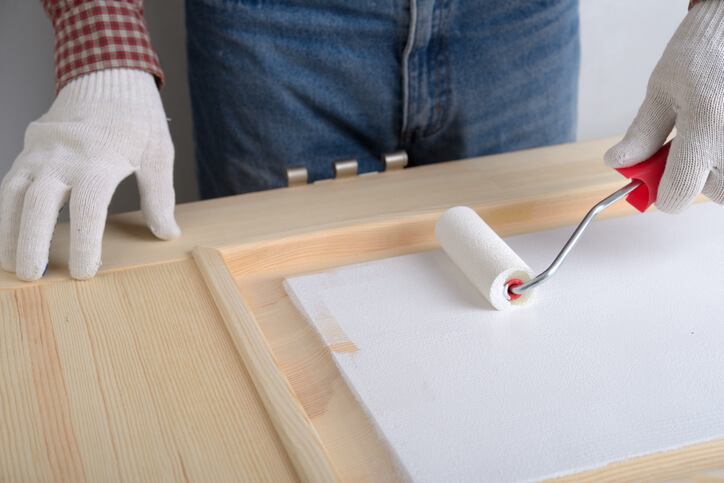Are you thinking of giving a different look to your house? Lacquering doors is one of the small reforms that has more influence on the decoration of a house. By modifying the color and texture of an element so present in all rooms, we can completely change the overall aesthetics of any place. Do you think it can be very difficult to carry out this work?
In this article we explain everything you need to know about lacquering doors, from the materials and tools you will need, to the step-by-step instructions for perfect results. In addition, we answer the most common questions that people ask about this task, you will see how you can improve the decor of your home in a very simple way!
Materials and tools you need to lacquer doors
If you dare to lacquer the doors of your house, you will need some essential materials. Of course, the primer and the lacquer itself for doors and windows are the main thing, but you will also need sander and hand sandpaper, wood filler, screwdriver, masking tape, bucket, tray, brush and roller, as well as papers and felts for the protection of the floor and any nearby elements.
Step-by-step instructions for lacquering doors at home
This process is so simple that to complete it you will only need, in general, three simple steps. Of course, each one of them has its own processes and particularities, but don’t let anyone tell you that lacquering doors is a complicated task! Here is an easy explanation of how to do it.
Prepare the door to be lacquered
The first thing you must do to lacquer doors is to disassemble them completely. To do this, it is important that you remove them from the frame by the hinges and then disassemble with the screwdriver all the hardware, such as the handle and the hinges themselves. Afterwards, you should protect the surface you are going to work on and follow the next two steps.
Clean and sand the surface

To remove any previous coat of paint or varnish, it is very important that you completely sand the entire wood. Use a suitable sander for larger surfaces and hand sandpaper for the edges and bends of any decorative motifs that may be present. When you have finished, clean the entire door thoroughly to avoid the appearance of roughness when lacquering.
Fills imperfections and plugs holes
To make the lacquered doors as perfect as possible, the next step we are going to take is to look carefully for any imperfections in the wood. The putty we mentioned when talking about the necessary materials is precisely to fill scratches or holes, leaving the surface perfectly smooth.
How to apply paint layer by layer
This is the key moment when it comes to lacquering doors. First of all, it is highly recommended to prepare the wood with a coat of primer, taking into account that we have previously sanded it and, therefore, it is a porous surface. Once we have applied this first product, the lacquer will settle much more easily.
After letting the primer dry for the time indicated by the manufacturer, we can apply the lacquer, always using a roller on flat surfaces and a brush in the corners. To lacquer doors it is essential to do it homogeneously, so you must also stir the product properly before starting to spread it on the wood.
Allow to dry and perfect the finish
In this last step we must again pay attention to the instructions included in the enamel. How long does the drying time indicate? You must respect it scrupulously and then check very well the finishes to decide if it is convenient to apply a new coat -this happens frequently-. In that case, repeat this step and the previous one and do the same, from the beginning, to lacquer the door frames.
What do you need to know before lacquering wood doors?
Despite the simplicity of the process, it is common that some doubts arise to prevent some mistakes that are avoidable. As it is possible that they have arisen when you read our step by step on how to lacquer doors, we are ready to answer the most common questions about this DIY task.
What type of wood can be lacquered?
In reality, this factor is not usually decisive when lacquering doors. Generally, the wood should be as uniform as possible and free of defects, which is true in most cases. However, there are no limitations in terms of the type of wood, although the lacquering process is much more expensive on coarse-grained surfaces.
What is the difference between painting and lacquering?
The main difference between lacquering doors or painting them lies mainly in the finishes we can achieve and, of course, in the product used. In the first case, we will generally apply several coats and the result is usually more defined and homogeneous, while if we use paint we cannot expect a completely perfect appearance.
What is better to paint or lacquer doors?

The answer to this question can be answered with the previous one, although there are other reasons that explain it even better. Lacquer is a more expensive product than paint, but it is also more durable and easier to maintain. The process of lacquering doors involves more work and is usually more expensive, although learning to do it with your own hands will save you a lot of money.
What happens if I don’t sand a door before painting it?
Doors, like most of the furniture we can find in a house, do not usually have natural wood, they are always coated with varnishes or paints. Applying lacquer directly on this surface is a mistake because it would considerably reduce the adherence and, therefore, the durability of the finishes, which also would not be perfect.
Why learn how to lacquer wood doors?
Lacquering doors is a task that, as you have seen, involves different steps and several coats of paint. Although it is not a complex task, it requires some time and care that translates into time and labor. At the same time, the process is much longer when you depend on third parties, since you never know how many days will pass between coats.
So, taking into account the reduction of time and, above all, the economic savings that this can lead to, it seems clear that learning how to lacquer doors can be very profitable. Limiting expenses to the purchase of the necessary materials and tools makes a big difference in home renovations, in addition to the satisfaction of doing it to your liking and with your own hands.



